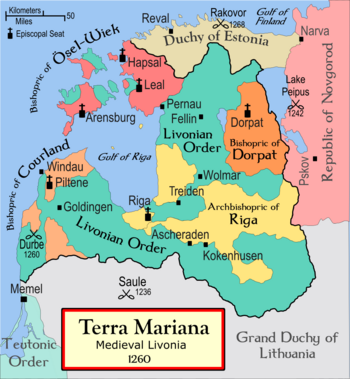Archbishopric of Riga facts for kids
Quick facts for kids
Archbishopric of Riga
|
|||||||||||||||||
|---|---|---|---|---|---|---|---|---|---|---|---|---|---|---|---|---|---|
| 1186–1561 | |||||||||||||||||

Archbishopric of Riga (in yellow), shown within Terra Mariana
|
|||||||||||||||||
| Status | Prince-Bishopric of Terra Mariana | ||||||||||||||||
| Capital | Riga | ||||||||||||||||
| Common languages | Latin Low German Livonian Latvian |
||||||||||||||||
| Religion | Roman Catholic | ||||||||||||||||
| Government | Theocracy | ||||||||||||||||
| Archbishop of Riga | |||||||||||||||||
|
• 1245–73
|
Albert Suerbeer (first) | ||||||||||||||||
|
• 1539–63
|
Wilhelm von Brandenburg (last) | ||||||||||||||||
| Historical era | Middle Ages | ||||||||||||||||
|
• Established
|
1186 | ||||||||||||||||
|
• Disestablished
|
1561 | ||||||||||||||||
| Currency | Livonian Penny Livonian Schilling |
||||||||||||||||
|
|||||||||||||||||
The Archbishopric of Riga was an important religious and political area in Medieval Livonia. This region is now part of modern-day Latvia and Estonia. It was like a small country ruled by an archbishop, who was a high-ranking church leader. The archbishopric was part of the Holy See, which is the central government of the Catholic Church.
It started in 1186 as a smaller church area called the bishopric of Livonia. This was in a place called Ikšķile. Later, it moved to the city of Riga in 1202 and became the bishopric of Riga. In 1255, it was made into an archbishopric, which is a bigger and more important church area.
Who Ruled Riga?
The archbishops of Riga were not just church leaders. They were also the actual rulers of the city of Riga and the lands around it. This continued until 1561.
During this time, a big change happened in Europe called the Reformation. Many people started to follow Lutheranism instead of Catholicism. Because of this, the church lands, including the Archbishopric of Riga, became part of the government's control instead of the church's. This is called "secularization."
The church leadership (called the Episcopal see) was brought back for the Catholic Church in 1918. It became a smaller church area called a diocese. Then, in 1923, it was made into an archdiocese again.
Archbishops of Riga: A List
Here is a list of the important church leaders who ruled the Archbishopric of Riga over the centuries. They played a big role in the history of the region.
| Bishopric of Livonia (Bishopric of Üxküll) 1186–1255 |
||
|---|---|---|
| 1186–1196 | Saint Meinhard | |
| 1196–1198 | Berthold of Hanover | |
| 1199–1202 | Albert of Riga | |
| Bishopric of Riga 1202–1255 |
||
| 1202–1229 | Albert of Riga | |
| 1229–1253 | Nikolaus von Nauen | |
| 1245–1255 | Albert Suerbeer | |
| Archbishopric of Riga 1255–1561 |
||
| 1255–1273 | Albert Suerbeer | |
| 1273–1284 | Johannes I of Lune | |
| 1285–1294 | Johannes II of Vechten | |
| 1294–1300 | Johannes III of Schwerin | |
| 1300–1302 | Isarnus Tacconi of Fontiès-d'Aude | |
| 1303–1310 | Jens Grand titular, never came to Riga |
|
| 1304–1341 | Friedrich von Pernstein | |
| 1341–1347 | Engelbert von Dolen | |
| 1348–1369 | Bromhold von Vyffhusen | |
| 1370–1374 | Siegfried Blomberg | |
| 1374–1393 | Johannes IV von Sinten | |
| 1393–1418 | Johannes V von Wallenrodt | |
| 1418–1424 | Johannes VI Ambundi | |
| 1424–1448 | Henning Scharpenberg | |
| 1448–1479 | Silvester Stodewescher | |
| 1479–1484 | Sede vacante (empty seat) | |
| 1484–1509 | Michael Hildebrand | |
| 1509–1524 | Jasper Linde | |
| 1524–1527 | Johannes VII Blankenfeld | |
| 1528–1539 | Thomas Schöning | |
| 1539–1563 | Wilhelm von Brandenburg | |
A new church area called the Bishopric of Livonia was created in Latgalia in 1621. This happened when the area was part of the Polish–Lithuanian Commonwealth.
Coins of Riga
The Archbishops of Riga were very clever when it came to making money. They brought back old ways of making coins that hadn't been used since the Roman Empire fell.
After the year 1418, the names of the archbishops and the years they ruled were put on Livonian pennies. These coins have been found by archaeologists. Often, these coins are the only way we know about the lives of these archbishops. No Livonian pennies from before 1418 have been discovered.
See also
- Bishopric of Courland
- Bishopric of Dorpat
- Bishopric of Ösel-Wiek
- Bishopric of Reval
- Livonian Crusade
- Livonian Brothers of the Sword
- Monastic state of the Teutonic Knights



